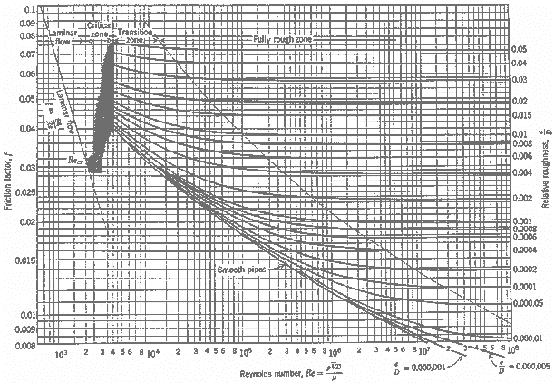| Pressure losses in the pipes, rate of flow (laminar, turbulent, critical zone), viscosity, calculation of the Reynolds number, influences rate of antifreeze (glycol). |

| _You are in the heading |
|
The calculation of the linear pressure loss, that corresponding to the general flow in a rectilinear conduit, is given by the following general formula:
The expression above shows that calculations of pressure losses rest entirely on the determination of the coefficient L.
The nature of the type of flow of a fluid is determined by the
value of the Reynolds number. The various types of flows are visualized by the chart of the diagram
of Moody using the Reynolds number for the x axis and the factor
of friction F for the y axis. The mode of flow of a fluid is characterized in 3 forms:
The Reynolds number is no dimensional (thus without units). It
combines 3 significant characteristics of the flow and the fluid:
speed, density and viscosity. The diameter is necessary to make
the number no dimensional. One calls the diameter the characteristic
length. A Reynolds number of 2000 or less indicates a flow in laminar
mode while a number of 4000 where more a turbulent flow indicates.
The Reynolds number is defined is:
Reynolds number is inversely proportional to kinematics viscosity.
The viscosity of a fluid is a characteristic which makes it possible to determine resistance to the movement of the fluid. The higher kinematic viscosity will be and the more difficult it will be to move the fluid in the pipe. Kinematics viscosity (v is the ratio of dynamic viscosity on the density of the fluid.
Laminar flow (Re £ 2000) In rate of laminar, the nature or the surface quality of the interior
walls of the lines does not intervene in the calculation of the
pressure loss. The loss pressure is determined by the following function:
The laminar flow meets in practice only in the transport and the handling of the viscous fluids, such as the crude oil, fuel oil, oils, etc. Turbulent flow (Re > 2000) In the critical zone, i.e. between 2000 and 4000 Reynolds the formula
of computation employed will be treated in the manner that in situation
of mode of turbulent flow. In rate of turbulent, the factor of friction is translated by the formula of Colebrook considered as that which translates best the phenomena of flow into turbulent mode. It is noted that this formula is in implicit form; consequently search can be done only by successive approaches (iterative calculation) With:
Last update:
|
||||||||||||||||||||||||||||||||||||||||||||||||||||||||||||||||||||||||||||||||||||||||||||||||||||||||||||||||||||||
Copyright © 2003-2014 - ThermExcel - All Rights Reserved

